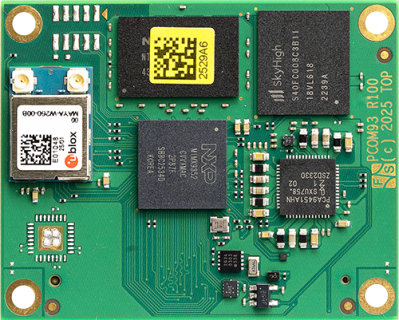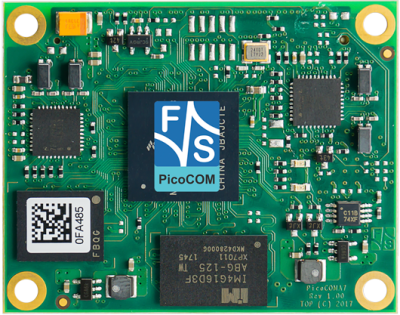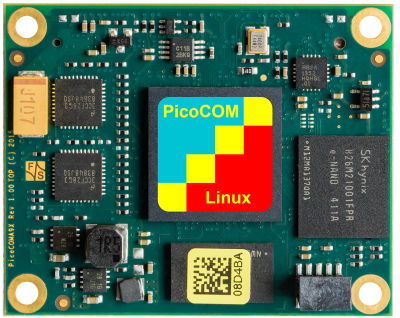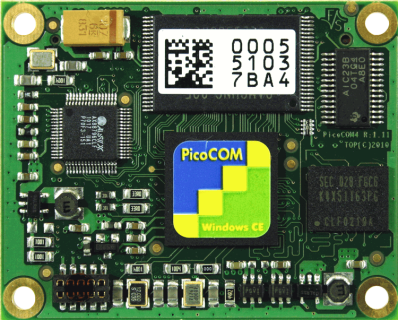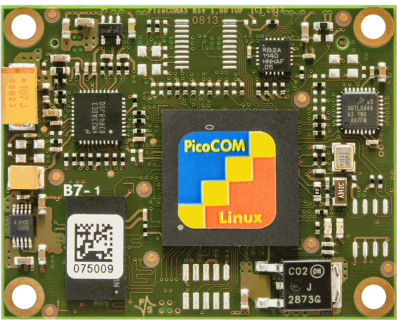PicoCOM
PicoCOM – Zukunftssichere Embedded-Plattform
Die PicoCOM-Modulfamilie ist seit vielen Jahren eine bewährte Basis für kompakte Embedded-Systeme. Die Hardware selbst bleibt noch viele Jahre verfügbar. Viele bestehende Designs nutzen jedoch noch Microsoft Windows Embedded Compact 2013, das in 2028 ausläuft und keine Sicherheitsupdates mehr erhält.
Mit dem bevorstehenden Cyber Resilience Act (CRA), der ab Ende 2027 verbindlich wird, steigen die Anforderungen an Sicherheit, Updatefähigkeit und Software-Transparenz deutlich. Hersteller müssen sicherstellen, dass ihre Produkte über den gesamten Lebenszyklus hinweg geschützt, wartbar und nachvollziehbar bleiben.
Der nächste Schritt: PicoCOM93 mit NXP i.MX93
Die neue PicoCOM93 wurde speziell entwickelt, um diesen Wandel zu unterstützen.
Sie basiert auf dem aktuellen NXP i.MX93 Prozessor und bietet eine moderne, Linux-basierte Plattform mit integrierten Sicherheitsfunktionen und langfristiger Verfügbarkeit.
Hauptmerkmale:
-
Security by Design: Hardware-basierte Sicherheitsfunktionen durch die integrierte EdgeLock Secure Enclave – für sicheres Booten, Schlüsselverwaltung und Vertrauensanker gemäß CRA-Anforderungen.
-
Zuverlässige Update-Strategie: Großzügiger eMMC-Speicher ermöglicht A/B-Updates und Over-the-Air (OTA)-Mechanismen für eine sichere Updatefähigkeit.
-
Transparente Softwarearchitektur: Auf Basis von Linux Yocto – ideal für reproduzierbare Builds, SBOM-Erstellung (Software Bill of Materials) und langfristige Wartbarkeit.
-
Konnektivität: Verfügbar auch mit Wi-Fi 6 und Bluetooth, ideal für moderne IoT- und Industrieanwendungen..
-
Langzeitverfügbarkeit: Industrietaugliches Design mit langfristig verfügbaren Komponenten für stabile Produktzyklen.
Mit der PicoCOM93 erhalten Entwickler eine leistungsfähige, energieeffiziente und zukunftssichere Plattform, um den Wechsel von Windows CE zu Linux zu vollziehen – konform mit den kommenden Anforderungen des Cyber Resilience Act.
| PicoCOM1 | PicoCOM1.2 | PicoCOMA5 | PicoCOMA9X | PicoCOMA7 | PicoCOM93 | |
| Status | No New Developments | Production | Production | Production | Production | Samples |
| CPU | - | - | - | - | - | - |
| Typ | ATMEL | NXP i.MX 6UL | NXP Vybrid | NXP i.MX 6SoloX | NXP i.MX 6ULL | NXP i.MX 93 |
| Kern | ARM 926 EJ | ARM Cortex-A7 | ARM Cortex-A5 + Cortex-M4 | ARM Cortex-A9 Cortex-M4 |
ARM Cortex-A7 | ARM Cortex-A55 Cortex-M33 NPU |
| Anzahl Kerne | - | 1 | Single-/Dual-Core | 1x A9 + M4 | 1 | 2x A55 + M33 |
| Frequenz | 210 MHz | max. 900MHz | max. 500MHz + 167 MHz | max. 1GHz + 200 MHz | max. 900MHz | 1.7GHz + 250MHz |
| L2-Cache | - | 128KB | 512KB | 256KB | 128KB | 2x64kB L2 + 256kB L3 |
| NPU | - | - | - | - | - | 0.5 TOPS |
| GPU | - | - | - | 2D, 3D | - | PXP |
| Security | - | - | - | - | - | - |
| Secure Element | - | - | - | - | - | SE050, Edgelock Secure Enclave |
| Betriebssystem | - | - | - | - | - | - |
| Linux | 2.6 (Emlix Eval/ Pro) (uboot installed) |
Buildroot/Yocto (uboot installed) |
Buildroot (uboot installiert) |
Buildroot Yocto (uboot installed) |
Buildroot Yocto (uboot installed) |
Yocto (uboot installed) |
| Windows | CE/Compact (EBoot installed) |
CE/Compact (EBoot installed) |
CE/Compact (EBoot installed) |
CE/Compact (EBoot installed) |
CE/Compact (EBoot installed) |
11 IoT Enterprise (UEFI installed) |
| Echtzeit | - | - | - | FreeRTOS | - | - |
| Speicher | - | - | - | - | - | - |
| Flash | 512MB SLC NAND | 512MB SLC NAND | 512MB SLC NAND | 512MB SLC NAND | max. 512MB SLC NAND | 64k EEPROM |
| eMMC | - | - | - | - | - | max. 64GB |
| RAM | 32MB+ | max. 512MB | max. 512MB | max. 512MB DDR3L x16 | max. 1GB DDR3L x16 | 2GB LPDDR4 x16 |
| Schnittstellen | - | - | - | - | - | - |
| SD-Karte | extern | 1x extern | 1x extern | 1x SDIO | 1x extern | 1x SDIO |
| Ethernet | 10/ 100MB | 10/100Mb | 2x 10/100Mb IEEE 1588 |
1-2x 10/100Mb IEEE 1588 |
1-2 10/100MB IEEE1588 | 2x 100MB Phy |
| WLAN | - | - | - | - | - | WIFI6 (2.4/ 5GHz) |
| BT | - | - | - | - | - | 5.4 |
| USB Host | 1-2 (2.0 FS) | 1x | 1-2x | 1x | 1x | 1x |
| USB Device | 0-1 (2.0 FS) | 1x | 1x | 1x | 1x | 1x |
| CAN | 1 | 2x | 1-2x | 1-2x | 1-2x | 2x CAN-FD |
| UART | 1x mit Modemsignalen, Baudrate 115200 1x mit RTS/ CTS, max. Baudrate 115200 1x mit max. Baudrate 115200 |
6x | 3x | 2-3x | 3x | 3x |
| I2C | 1 | 2x | 1-2x | 1x | 1-2x | 2x |
| SPI | opt. | 2x | 1x | 1x | 1x | 1x |
| Audio | 1x Audio Codec Line Out (L/ R) 1x Audio Codec Line In (L/ R) 3x Analog In (10Bit resolution) |
Line In/Out/analog | Line In/Out | Line In/Out | Line In/Out | Line In/Out opt. I2S |
| Digital I/O | - | - | - | max. 48 | max. 48 | |
| ADC | - | - | - | - | - | 4x |
| Touch Panel | - | - | 4-wire, analog resistive PCAP-Touch via I2C |
4-wire, analog resistive PCAP-Touch via I2C |
4-wire, analog resistiver PCAP-Touch über I2C | TSC2004 |
| RTC | - | - | - | - | PCA8565 | PCF85263ATL |
| sonstige Schnittstellen | - | - | 2x 12Bit ADC | - | - | - |
| Display | - | - | - | - | - | - |
| RGB | - | - | 16/18bit | 16/18bit | 16/18 Bit | 18 Bit |
| LVDS | - | - | extern | - | external | - |
| Allgemein | - | - | - | - | - | - |
| V_IN | +3,3V | +3,3V DC/ ±5% | +3,3V DC/ ±5% | +3,3V DC/ ±5% | +3,3V DC/ ±5% | +3,3V DC/ ±5% |
| T_AMB | -20°C - +85°C | 0°C - +70°C -25°C - +85°C |
0°C - +70°C -20°C - +85°C |
0°C - +70°C -40°C - +85°C |
0°C - +70°C -25°C - +85°C |
0°C - +70°C -25°C - +85°C -40°C - +85°C |
| Größe | 40x50mm | 40x50mm | 40x50mm | 40x50mm | 40x50mm | 40x50mm |
| Verfügbarkeit | - | 2035+ Windows: May, 2028 |
2027+ Windows: May, 2028 |
2035+ Windows: May, 2028 |
2035+ Windows: May, 2028 |
2038+ |
| PicoCOM1 | PicoCOM1.2 | PicoCOMA5 | PicoCOMA9X | PicoCOMA7 | PicoCOM93 |

